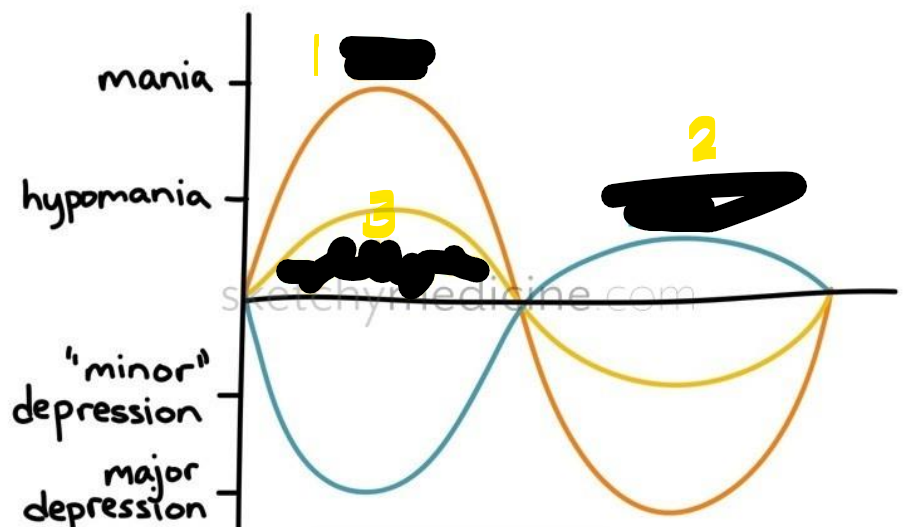Lesson 6: Mood Disorders, Depressive Disorders, Bipolar Disorders
1/57
There's no tags or description
Looks like no tags are added yet.
Name | Mastery | Learn | Test | Matching | Spaced |
|---|
No study sessions yet.
58 Terms
Mood Disorders
More intense and harder to manage than normal feelings of sadness. Primarily affects emotional state, experience long periods of extreme happiness, extreme sadness or both.
Mania
Makes an individual abnormally exaggerated elation, joy, or euphoria. Individuals find extreme pleasure in every activity. Impairment in functioning
D - Distractibility
I - Impulsivity
G - Grandiosity
F - Flight of ideas
A - Activity increases
S - Sleep deficit
T - Talkativeness
Signs and Symptoms of Mania:
Hypomania
Less severe version of a manic episode that does not cause marked impairment in social or occupational functioning.
Anhedonia
loss of energy and inability to engage in pleasurable activity.
Unipolar Mood Disorder
Individuals who suffers either depression or mania
Feeling of worhtlessness/hopelessness
Insomnia
Eating Problems
Suicidal ideations
Depressive episode signs/symptoms
Unipolar Depression
Have with depressive episodes but no history of mania, return to a normal or nearly normal mood when their depression lifts. IIlan lang mga symptoms
Bipolar Disorder
Have periods of mania that alternate with periods of depression.
Major Depressive Episode
Most commonly diagnosed and most severe depression. Purely depressive symptoms. Leading to MDD, nagkakasabay-sabay lahat ng symptoms
5 or more symptoms for 2 weeks (out of 9)
At least 1 symptoms is either (1) depressed mood or (2) loss of interest or pleasure.
Criteria for Major Depressive Disorder
Puberty
Major Depressive Disorder may first appear at any age, but the likelihood of onset markedly with ____
TRUE
T or F: Depression with earlier age at onset are more familial and more likely to involve personality disturbances
Anti-depressant and Psychotherapy
Exercise
Positive Psychotherapy
Interpersonal Therapy
Treatments of MDD
Persistent Depressive Disorder (Dysthymia)
Often has an early and insidious onset and chronic course
Must be in a depressed mood for most of the day for the majority of days over at least 2 years period
Criteria for Persistent Depressive Disorder
Double Depression
Suffers from both MDE and PDD with fewer symptoms
Premenstrual Dysphoric Disorder
5 symptoms, menstrual cycle is done but symptoms are persistent (recurrent per month). At risk to leading Postpartum Depression
Bipolar Disorder I
Mania + MDE + 1 week
Bipolar Disorder I with Psychotic Features
Mania + Hallucination & Delusions + 1 Week
Late adolescence or Early Adulthood
Symptoms of mania in BD1 occur in distinct episodes and typically begin in ____
TRUE
T or F: BD1 is more extreme than BD2 because of extreme mood.
Bipolar Disorder II
Hypomania + MDE + 4 Days; Highly recurrent, also have seasonal variation in mood compared to those with BD1.
Bipolar Disorder II with Psychotic Features
Hypomania + MDE + Hallucinations and Delusions
Low serotonin; High Norepinephrine
Mania may be link to _______ activity accompanied by ______ activity
Pharmacological treatment
Mood stabilizers
Cognitive Behavioral Therapy
Psychoeducation
Treatments for BD1 & BD2
Cyclothymic Disorder
Milder but more chronic version of Bipolar Disorder. 2 years episode of hypomanic and depressive experiences which do not meet the full DSM-5 diagnostic criteria for hypomania or MDD; floating, in the middle.
1 Year
In Cyclothymic Disorder, duration is
2 years (Adult) and ____ (Children)
10 years old
Experience of onset of mood symptoms in Cyclothymic Disorder is before _____
Bipolar I
The DSM-5 indicates that risk factors for Cyclothymic Disorder are having a first degree relative with _____
Mood stabilizers (Lithium Carbonate) in conjuction with CBT and support groups
Treatment for Cyclothymic Disorder
BD1
BD2
Cyclothymia
Fill out the blanks

Neurotransmitter systems - low serotonin, low dopamine, high cortisol during stressful events
Shrinkage in Hippocampus
Low hippocampal volume for depressed individual
Biological Dimensions Causes of MDD & BPD
Stress and Trauma
Learned Helplessness Theory
Psychological Dimensions Causes of MDD and BPD
Biological and Psychological Dimensions
Top 2 causes of MDD and BPD
Learned Helplessness Theory
Anxiety is the first response to stressful situation, depression may follow with hopelessness
Anti-depressant medications - SSRIs & Monoamine Oxidase Inhibitors (MAOI)
Lithium Carbonate
Cognitive Therapy
Maintenance Treatment
Treatment Statistics
Selective-Serotonin Reuptake Inhibitors (SSRIs)
Specifically block the presynaptic reuptake of serotonin; Fluxotine (Prozac) best known drug in this class
Monoamine Oxidase Inhibitors (MAOI)
Block the enzyme MAO that breaks down such neurotransmitters as norepinephrine and serotonin.
Lithium Carbonate
Mood stabilizing drug that prevent manic episodes
Cognitive Therapy
Clients are taught to examine carefully their thought processes while they are depressed and to recognize “depressive” errors in thinking
Maintenance Treatment
Prevent relapse or recurrence over the long term. Includes CBT with psychoeducation
TRUE
T or F: Women are twice as likely to have mood disorders as men.
Female
MDD in adolescence is largely a _____ disorder
Death Seeker
Clear intention to end their lives at the time they attempt suicide
Death Initiators
Clearly intent to end their lives but act out of a belief that the process is already under the way and they are simply hastening the process. Pinapahaba or binabagalan muna
Death Ignorers
Do not believe that their self-inflicted death will mean the end of their existence. Walang sense of purpose, naniniwala na walang magbabago kahit mag pakamatay.
Death Darers
Experience mixed feelings or ambivalence about their intent to die.
Suicidal Ideation
Thinking seriously about suicide
Suicidal Plans
Formulation of a specific method for killing oneself
Suicidal Attempts
The person survives from attempts.
Altruistic
Egoistic
Anomic
Fatalistic
Emile Durkheim Suicide Types
Altruistic
Dishonor to self, family, or society
Egoistic
Loss of social supports as an important provocation for suicide
Anomic
Result of marked disruptions, such as sudden loss of job
Fatalistic
Loss of control over one’s own destiny
Stressful events
Mood and thought changes
Alcohol and other drug use
Mental disorders
Modeling
Common triggering factors:
TRUE
T or F: Anyone in the state of doing suicide does not feel anything, cannot think of anything. just blank.